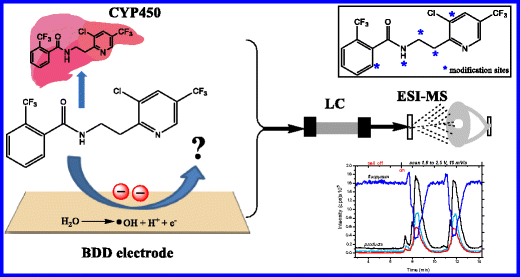Analytical and Bioanalytical Chemistry ( IF 3.8 ) Pub Date : 2018-02-17 , DOI: 10.1007/s00216-018-0933-x Tessema F. Mekonnen , Ulrich Panne , Matthias Koch
Biotransformation processes of fluopyram (FLP), a new succinate dehydrogenase inhibitor (SDHI) fungicide, were investigated by electrochemistry (EC) coupled online to liquid chromatography (LC) and electrospray mass spectrometry (ESI-MS). Oxidative phase I metabolite production was achieved using an electrochemical flow-through cell equipped with a boron-doped diamond (BDD) electrode. Structural elucidation and prediction of oxidative metabolism pathways were assured by retention time, isotopic patterns, fragmentation, and accurate mass measurements using EC/LC/MS, LC-MS/MS, and/or high-resolution mass spectrometry (HRMS). The results obtained by EC were compared with conventional in vitro studies by incubating FLP with rat and human liver microsomes (RLM, HLM). Known phase I metabolites of FLP (benzamide, benzoic acid, 7-hydroxyl, 8-hydroxyl, 7,8-dihydroxyl FLP, lactam FLP, pyridyl acetic acid, and Z/E-olefin FLP) were successfully simulated by EC/LC/MS. New metabolites including an imide, hydroxyl lactam, and 7-hydroxyl pyridyl acetic acid oxidative metabolites were predicted for the first time in our study using EC/LC/MS and liver microsomes. We found oxidation by dechlorination to be one of the major metabolism mechanisms of FLP. Thus, our results revealed that EC/LC/MS-based metabolic elucidation was more advantageous on time and cost of analysis and enabled matrix-free detection with valuable information about the mechanisms and intermediates of metabolism processes.

Oxidative metabolism of fluopyram
中文翻译:

在线联用液相色谱-质谱联用电化学方法预测杀真菌剂氟吡虫酰胺的生物转化产物,并与体外微粒体测定法进行比较
通过在线耦合到液相色谱(LC)和电喷雾质谱(ESI-MS)的电化学(EC)研究了新型琥珀酸脱氢酶抑制剂(SDHI)杀菌剂氟吡草胺(FLP)的生物转化过程。使用配备了硼掺杂金刚石(BDD)电极的电化学流通池可实现氧化I相代谢产物的生产。保留时间,同位素模式,碎片和使用EC / LC / MS,LC-MS / MS和/或高分辨率质谱(HRMS)进行的精确质量测量可确保结构阐明和氧化代谢途径的预测。通过将FLP与大鼠和人的肝微粒体(RLM,HLM)进行孵育,将EC获得的结果与常规的体外研究进行了比较。FLP的已知I相代谢产物(苯甲酰胺,苯甲酸,7-羟基,8-羟基,7,通过EC / LC / MS成功模拟了8-二羟基FLP,内酰胺FLP,吡啶基乙酸和Z / E-烯烃FLP)。在我们的研究中,首次使用EC / LC / MS和肝微粒体预测了包括酰亚胺,羟基内酰胺和7-羟基吡啶基乙酸氧化代谢产物的新代谢产物。我们发现脱氯氧化是FLP的主要代谢机制之一。因此,我们的研究结果表明,基于EC / LC / MS的代谢阐明方法在分析的时间和成本上更为有利,并且能够进行无基质检测,并获得有关代谢过程机理和中间体的宝贵信息。在本研究中,我们首次使用EC / LC / MS和肝微粒体预测了7-羟基吡啶基乙酸氧化代谢产物。我们发现脱氯氧化是FLP的主要代谢机制之一。因此,我们的研究结果表明,基于EC / LC / MS的代谢阐明方法在分析的时间和成本上更为有利,并且能够进行无基质检测,并获得有关代谢过程机理和中间体的宝贵信息。在本研究中,我们首次使用EC / LC / MS和肝微粒体预测了7-羟基吡啶基乙酸氧化代谢产物。我们发现脱氯氧化是FLP的主要代谢机制之一。因此,我们的研究结果表明,基于EC / LC / MS的代谢阐明方法在分析的时间和成本上更为有利,并且能够进行无基质检测,并获得有关代谢过程机理和中间体的宝贵信息。

氟吡喃的氧化代谢











































 京公网安备 11010802027423号
京公网安备 11010802027423号